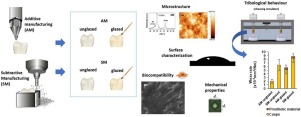当前位置:
X-MOL 学术
›
Dent. Mater.
›
论文详情
Our official English website, www.x-mol.net, welcomes your
feedback! (Note: you will need to create a separate account there.)
Suitability of 3D printed pieces of nanocrystalline zirconia for dental applications.
Dental Materials ( IF 4.6 ) Pub Date : 2020-01-27 , DOI: 10.1016/j.dental.2020.01.006 A C Branco 1 , R Silva 2 , T Santos 3 , H Jorge 4 , A R Rodrigues 5 , R Fernandes 5 , S Bandarra 6 , I Barahona 6 , A P A Matos 6 , K Lorenz 7 , M Polido 6 , R Colaço 8 , A P Serro 9 , C G Figueiredo-Pina 10
Dental Materials ( IF 4.6 ) Pub Date : 2020-01-27 , DOI: 10.1016/j.dental.2020.01.006 A C Branco 1 , R Silva 2 , T Santos 3 , H Jorge 4 , A R Rodrigues 5 , R Fernandes 5 , S Bandarra 6 , I Barahona 6 , A P A Matos 6 , K Lorenz 7 , M Polido 6 , R Colaço 8 , A P Serro 9 , C G Figueiredo-Pina 10
Affiliation

|
OBJECTIVES
The main goal of this work is to evaluate the suitability of nanostructured zirconia pieces obtained by robocasting additive manufacturing (AM), for dental applications.
METHODS
The density, crystalline structure, morphology/porosity, surface roughness, hardness, toughness, wettability and biocompatibility of the produced samples were compared with those of samples obtained by conventional subtractive manufacturing (SM) of a similar commercial zirconia material. Chewing simulation studies were carried out against dental human cusps in artificial saliva. The wear of the material was quantified and the wear mechanisms investigated, as well as the influence of glaze coating.
RESULTS
AM samples, that revealed to be biocompatible, are slightly less dense and more porous than SM samples, showing lower hardness, toughness and wettability than SM samples. After chewing tests, no wear was found both on AM and SM samples. However, the dental wear was significantly lower when AM samples were used as counterbody. Concerning the glazed samples, both coated surfaces and dental cusps suffered wear, being the cusps' wear higher than that found for unglazed samples. More, cusps tested against AM coated samples suffered less wear comparatively to those opposed to SM coated samples.
SIGNIFICANCE
Overall, the results presented in this paper show that AM processed nanostructured zirconia can be used in dental restorations, with important advantages from the point of view of processing and tribological performance. Moreover, the option for glaze finishing should be carefully considered both in SM and AM processed specimens.
中文翻译:

纳米晶氧化锆 3D 打印件适用于牙科应用。
目的 这项工作的主要目标是评估通过机器人铸造增材制造 (AM) 获得的纳米结构氧化锆片在牙科应用中的适用性。方法将所生产样品的密度、晶体结构、形态/孔隙率、表面粗糙度、硬度、韧性、润湿性和生物相容性与通过类似商业氧化锆材料的传统减材制造(SM)获得的样品进行比较。对人造唾液中的人类牙尖进行了咀嚼模拟研究。量化材料的磨损并研究磨损机制以及釉涂层的影响。结果 AM 样品具有生物相容性,与 SM 样品相比,其密度稍低,多孔性更高,硬度、韧性和润湿性也比 SM 样品低。经过咀嚼测试,AM 和 SM 样品均未发现磨损。然而,当使用增材制造样品作为配对物时,牙齿磨损显着降低。对于上釉样品,涂层表面和牙尖都遭受磨损,其中尖瓣的磨损高于未上釉样品的磨损。此外,与 SM 涂层样品相比,针对 AM 涂层样品进行测试的尖头磨损更小。意义 总体而言,本文提出的结果表明,增材制造加工的纳米结构氧化锆可用于牙科修复,从加工和摩擦学性能的角度来看,具有重要的优势。此外,在 SM 和 AM 加工样品中,应仔细考虑釉面精加工的选择。
更新日期:2020-01-27
中文翻译:

纳米晶氧化锆 3D 打印件适用于牙科应用。
目的 这项工作的主要目标是评估通过机器人铸造增材制造 (AM) 获得的纳米结构氧化锆片在牙科应用中的适用性。方法将所生产样品的密度、晶体结构、形态/孔隙率、表面粗糙度、硬度、韧性、润湿性和生物相容性与通过类似商业氧化锆材料的传统减材制造(SM)获得的样品进行比较。对人造唾液中的人类牙尖进行了咀嚼模拟研究。量化材料的磨损并研究磨损机制以及釉涂层的影响。结果 AM 样品具有生物相容性,与 SM 样品相比,其密度稍低,多孔性更高,硬度、韧性和润湿性也比 SM 样品低。经过咀嚼测试,AM 和 SM 样品均未发现磨损。然而,当使用增材制造样品作为配对物时,牙齿磨损显着降低。对于上釉样品,涂层表面和牙尖都遭受磨损,其中尖瓣的磨损高于未上釉样品的磨损。此外,与 SM 涂层样品相比,针对 AM 涂层样品进行测试的尖头磨损更小。意义 总体而言,本文提出的结果表明,增材制造加工的纳米结构氧化锆可用于牙科修复,从加工和摩擦学性能的角度来看,具有重要的优势。此外,在 SM 和 AM 加工样品中,应仔细考虑釉面精加工的选择。











































 京公网安备 11010802027423号
京公网安备 11010802027423号